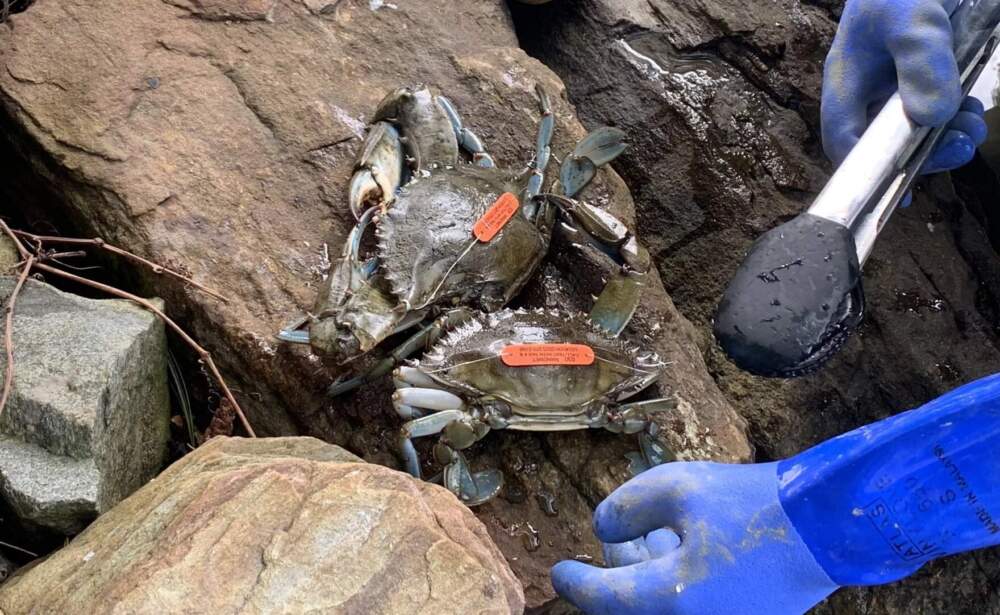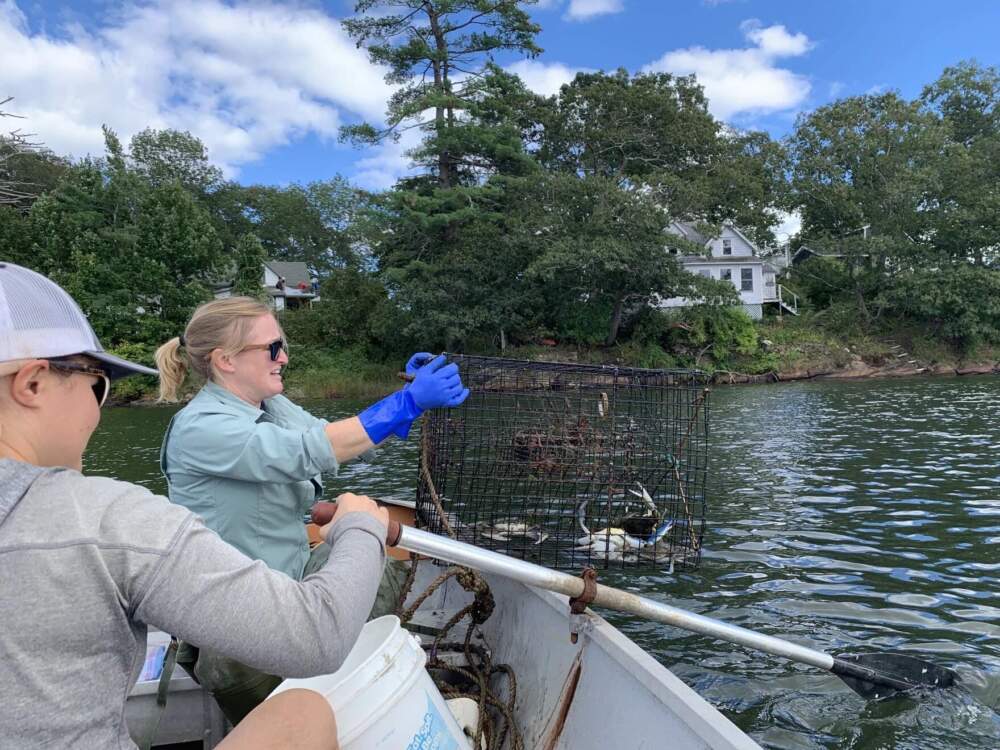Advertisement
Blue crabs are showing up more often in the warming Gulf of Maine

Laura Crane winds her way around a maze of shallow pools at the Webhannet Marsh near Wells, Maine. She stops at one pool with a small blue flag poking through the tall grass at the water's edge, grabs the rope lying nearby, and pulls.
"OK, first trap we already have two blue crabs, said Crane, as she hauls up a small, wire mesh trap from the muck.
And with metal kitchen tongs in hand, Crane attempts to pry away one of the crabs that's clutching one side. It's small, with a greenish gray shell and bright blue claws. She measures its size and determines that it's a male.
Crabs that have been caught before have a small notch clipped from their swimmer paddle. And after a lengthy battle with the kitchen tongs, Crane confirms that this crab has not been tagged.
"Lately we've been catching around 20 to 30 blue crabs in total per week between our 12 traps, which is way more blue crabs than we've caught in the past," said Crane, a research associate for the Wells National Estuarine Research Reserve.
Blue crabs, quintessential to the Chesapeake Bay and Gulf Coast, have been known to show up now and then in lobster traps. But about three to four years ago, scientists started hearing reports of more sightings.
"It's one of the many species that is expanding their range into the Gulf of Maine because conditions are changing, and that the Gulf of Maine is warming faster than 99% of the rest of the world's oceans. Blue crabs are taking advantage of that," said Jessie Batchelder, a fisheries project manager for the environmental research non-profit Manomet, which also studying blue crabs.
Under a busy Route 1 underpass near West Bath, Batchelder maneuvers a rowboat along the upper edge of the New Meadows River, and discovers four blue crabs in a single trap.
Manomet has been consistently catching blue crabs here since May, when the group first set these traps for the season.
"Based on seeing them move out into areas where we're catching them now in the fall suggests to me that they're moving out maybe into deeper waters to overwinter," Batchelder said.

Others are studying how blue crabs and other range-expanding species might affect the Gulf of Maine ecosystem. Blue crabs are aggressive competitors, said marine scientist Helen Cheng. She recalls watching a blue crab voraciously consume a baby lobster in an experiment tank.
"If that’s a snapshot of what we may end up seeing in the Gulf of Maine, that’s very concerning, especially if they can target smaller lobsters," said Cheng, a graduate fellow for the Wells Reserve. "That would also impact food web dynamics and even recruitment of American lobster."
Fishermen and shellfish harvesters, who have reported nearly 100 blue crab sightings to Manomet through an online dashboard, express mixed feelings about their growing presence.
Shellfish harvester Max Burtis said he found a blue crab while raking for clams near Brunswick almost three years ago.
"I am worried that the native species here won't really know what to do with the blue crab," he said. "I'm worried about baby lobsters. I'm worried about baby clams."
But Burtis says he does see potential benefits of a blue crab population here. They could help to control the invasive green crab, which feed on young lobsters, mussels and softshell clams. And Burtis said he'd actually like to see a commercial blue crab fishery in Maine some day.
"A couple generations ago you fish whatever is plentiful and pays the most in that season, that time of year," he said. "I like that more diverse approach. I think that's a little bit safer."
But not everyone feels the same way. Marine scientist Helen Cheng has surveyed lobster fishermen from Cape Cod to Downeast Maine about the arrival of range expanding species such as blue crabs. She says while some fishermen in southern New England are open to a potential blue crab fishery, many in Maine are more skeptical.
"Some of the responses were pretty bold," she said. "It was like, 'No, we only do lobster here, like that's what we've been doing.' And so there's this sense of pride and tradition for that. If they see change is happening and lobster is getting harder and harder to fish, then I think those mind shifts can start to happen."
Scientists stress that Maine does not yet have an established blue crab population, and that their research is still in its early days.
But there are signs that blue crabs of different life stages are now in the Gulf of Maine's warmer estuaries. Blue crab larvae have been caught since 2016. Egg-bearing females have been trapped farther north.
And back at the Webhannet Marsh, researcher Laura Crane pulls another trap, and discovers two blue crabs that have bonded together.
"So those two crabs that are kind of attached to each other are definitely a mating pair. Uh, in progress," she said, laughing.
But in order to achieve established populations here, Crane said the blue crab will also have to survive multiple Maine winters well into the future.
This story is a production of the New England News Collaborative. It was originally published by Maine Public.